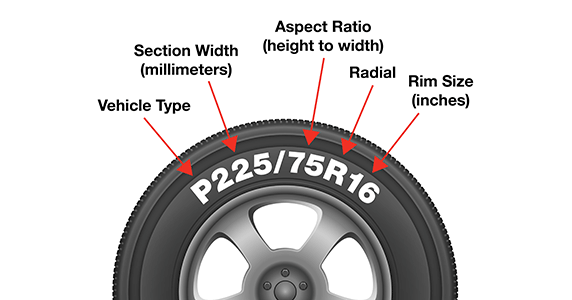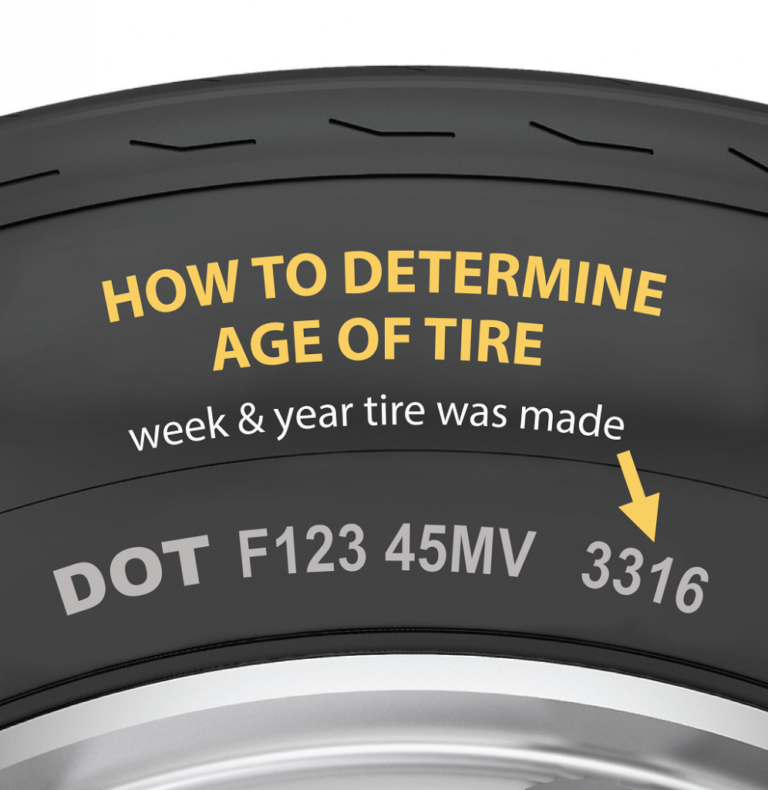TIRE PRESSURE
The correct tire pressure to inflate your tires can be located on the vehicle or tire placard or Vehicle Owners Manual and is the proper tire pressure to maintain, so your tires can give you maximum performance, including gas mileage and tread life. For proper results, make sure your tires haven't been driven for three hours before you check for air pressure. (Friction creates heat, which increases tire pressure and gives improper readings.) Be aware that the air pressure displayed on the tire sidewall is the maximum pressure, not the recommended tire pressure.
READING YOUR TIRES SIDEWALL
P= For Passenger Cars, SUVs, MiniVans and Light Trucks. LT = Heavy Load Trucks, Vans or SUVs. There may not always be a letter in your tire size. A tire starting with “P185” can be replaced with a tire starting with “185” and vice versa. Most websites will not show the starting letter.
-
Tire Wear: All tires eventually begin to experience wear. How the tire wears can indicate an alignment or pressure issue. The tire tread should wear evenly across the whole tire rather than on the inside or outside of the tire. The wear on your tires will happen regardless of how good of a driver you are, although it can be accelerated if you don’t take proper care of the tires.
Tire Age: Tire aging occurs when tire components, including the rubber, begin to change over time. This can happen due to environmental impacts, storage conditions, the amount of usage the tire sees when being driven, or the tire sitting with no use. -
Knowing how often to replace tires isn’t just about taking good care of your vehicle and preventing expensive mistakes. Tires are an essential part of your vehicle’s safety.
Worn or old tires can lead to a variety of problems, including:
Compromised road grip due to a worn-down tread
Blowouts that leave you stranded or even cause you to crash
Difficulty stopping and braking effectively
Additionally, uneven wheel alignments and balance problems will not only cause irregular and premature tire wear; they can cause expensive problems for your vehicle, leaving you with a hefty car repair bill in the future. -
Tread Wear. A tire’s tread depth is measured in 32nds of an inch. New tires have tread material from 9/32″ to 11/32″. A tire is considered unsafe when the tread is worn down to 2/32″.
Using the penny test method or a tread depth gauge, you can identify the tread depth to replace tires.
Many ask us, “Is the penny test for tires accurate? “
For the most part, the penny test is very reliable. We encourage people to use it as a starting point.
Bubbles and Bulges. A bulge on your tire usually indicates that the rigid internal frame of the tire has been damaged, allowing air pressure to reach the flexible outer layers of the tire. Any tires with sidewall bulges or bubbles should be replaced immediately, even if the tread status is acceptable.
Vibration. If your tires have been worn down unevenly, you may feel a vibration in the steering wheel when driving. Vibration can also be caused by poor alignment, so it is essential to have a tire professional determine the cause of the beat.
Sidewall Cuts or Cracks. Tire age is a common cause of tire sidewall cracking. All tires are subjected to different harsh conditions, so the rubber in the tires naturally degrades over time. Imagine an old rubber band that’s brittle and easily broken. The same effect happens to tires, even if the tires aren’t in use and stored in a place where cracking can occur. Typically, cracking is caused by sunlight, excessive heat, road surfactants, and ozone exposure. Conversely, cuts are usually caused by force – like hitting a rock or something sharp.
They embedded nails or stones. The issue must be addressed immediately if something is lodged in the tire. Even if the hole isn’t causing excessive leaking, ignoring a spot from something like a nail can lead to later problems for the driver. Moisture can leak into the tire, causing the steel parts to rust. Lodged items can weaken the area of the tire and possibly lead to dangerous blowouts if not dealt with promptly.
Visible damage. Abnormal wear patterns could indicate wheel misalignment, improper inflation pressure, a need for a tire rotation, or perhaps all of the above.
It damaged the valve caps. If the lid can’t be tightened enough, it will continuously loosen. If it’s too tight, the thread on the stem may become stripped. A damaged valve cap can leak air, allowing dirt, moisture, and debris to enter the tire.



